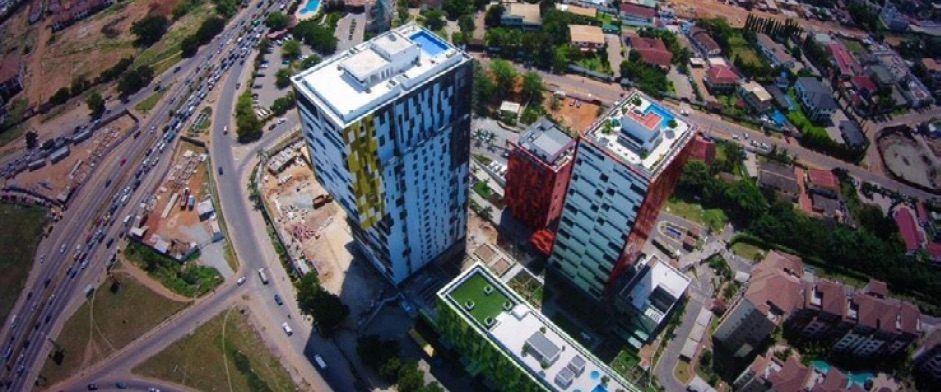African cities are growing rapidly, with buildings mushrooming in major centers around the continent. But scientists in Ghana are concerned that building materials could be radioactive and play havoc with occupants’ health.
“Normally, when you mention radiation, people think about a bomb,” says Francis Otoo, a scientist with the Ghana Atomic Energy Commission based in Accra. But radiation is present most of the time, he points out. Soil and rock, in particular, often contains some radioactive material and this can cause health problems when they are used in buildings like residential houses and office blocks.
Otoo and his colleagues have set out to measure the risk in Accra, Ghana’s biggest city. One quarry site, in particular, is cause for concern. Their results are published in Scientific African.
In developed nations, radioactivity in buildings is usually monitored to ensure it falls below safe levels. But in developing countries where building codes are weak and seldom enforced, it is a growing concern. Africa is urbanizing faster than any continent in history, and mega-cities like Accra, Lagos and Nairobi are already straining to meet the transport and housing needs of their growing citizenry.
Ghana is a case in point. Accra’s population is growing by more than 2% each year. But a study published in 2013 by the Bank of Ghana highlighted major challenges in the construction sector. “There are serious shortfalls in materials handling, safe working practices, quality and timeliness of construction,” it said. Where regulations exist they are often infringed upon, and infringements are rarely punished, it added.
To study the radiation levels in building materials in Accra, Otoo and his colleagues collected samples including soil, bricks, cement, rock, and concrete from 17 sites around the city. They tested them for three radioactive isotopes of Uranium (U), Thorium (Th) and Potassium (K), all three of which are known to cause problems for human health. They also monitored levels of radon, a radioactive gas that forms where radioactive elements break down.
Radon is particularly sinister, as it accumulates in enclosed spaces and causes lung cancer after extended exposure. In the United States, where radon is the second biggest cause of lung cancer after cigarette smoking, theEnvironmental Protection Agency recommends regular radon testing in homes below the 3rd floor. But In Ghana, there are no such regulations.
Living conditions in Ghana make radon a particular concern, Otoo adds because many houses are insufficiently ventilated. Ghana is hot and humid most of the year, and most new buildings are fitted with air conditioners. While this may make life more comfortable for their occupants, it can also result in radon gas accumulation, he says, since doors and windows stay closed most of the time. Indeed, in a study published by Otoo and others earlier this year in the journal Radioprotection, Ghanaian houses with air conditioning had higher radon levels than those without.
Thankfully, the radiation levels in the construction materials studied for the most recent paper found little cause for concern. All samples had levels below the world standards bar one: Gneiss rock quarried in the Shai Hills in the northern suburbs of Accra. Overall, the radiation safety concerns were “negligible”, Otoo and his co-authors write. But he says more sampling needs to be undertaken, as radioactivity levels in mines and quarries vary not only with geographical location, but also with depth. “Most of the time the deeper you go the more exposure you get.”
The paper is important, says a soil radioactivity expert in South Africa. “This is a very interesting study and agrees with our findings that gneiss has a high risk of cancer,” says Mannie Levin, an independent consultant who works on research projects related to radon gas around old gold mines in Krugersdorp. “The findings that the materials are safe for building construction is good.” However, he says more work needs to be done to study basements and enclosed spaces for radon. “Air circulation in such areas is required to ensure low radon exposure,”
Otoo says the study is part of a larger project to monitor radiation exposure in Ghana. This is not just looking at soils and building materials, but also at radiation exposure through food and water. The end product of the work, he says, is to produce appropriate reference levels to inform building regulations. “We don’t want to cause fear and panic. We want to be able to tell the people who mine or quarry: If you reach this depth, you need to get an investigation to see if the rock is alright to use.”
One of the main challenges Otoo and his team faced was the lack of locally-available technical equipment to do the testing. “We did most of the work in Italy,” he says.
Otoo’s link with Italy came about as a result of receiving a Ph.D. training fellowship grant by the International Atomic Energy Agency. This fellowship saw Otoo spend 18 months at the Centro Regionale di Radioprotezione in Udine. “This eventually contributed to my academic research especially the experimental work leading to this publication and also an award of my Ph.D. from the University of Ghana in 2015,” says Otoo. His Italian supervisor, Massimo Garavaglia, is a co-author on the paper.
Next, Otoo and his colleagues would like to monitor radiation levels in other cities in Ghana. There’s a huge amount left to do, he says, and the stakes are high. Buildings built today will house generations to come, he points out. “At the end of the day, we want to make an impact on people’s lives. The effect is not going to be seen now. It will pass on to the next generation.”
